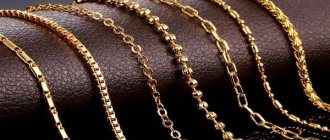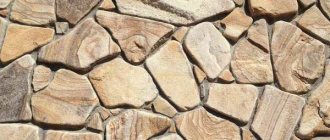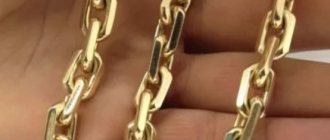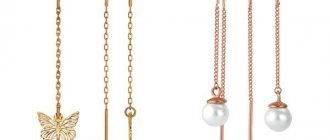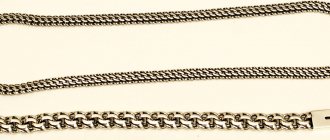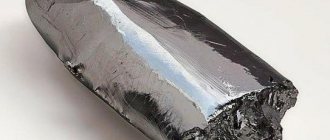- History of chain and chain fashion
- How are chains made? Machine knitting chains
- Stamping chains
- Anchor
- Strength
- Where are chains used for needlework?
Metal chains are almost the most popular type of accessories for jewelry. And one of the most assorted Chains for creating decorations and jewelry. Chains are used as an independent decoration, as a basis for pendants and pendants, and as a decorative element. This determines their size, shape, color, price and other diversity. What types of chains are there? How to choose the right one for a specific creative project? What can you safely save on, and what savings will result in increased costs? We'll talk about this and more further.
History of chain and chain fashion
The chain rampage proclaimed today by designers did not happen suddenly. Chains have been present in women's and men's jewelry, if not always, then since the beginning of human processing of metal. More precisely, initially the chain was not a decoration, but a clever way to add plasticity and flexibility to the most durable of natural materials.
Nowadays there are soft synthetic fibers, the strength of which is not inferior to metal. And once upon a time, the only thing stronger than metal was stone. But stone, unlike metal, is completely devoid of malleability (the ability to deform). That is, it was unthinkable to obtain fabric or rope from stone with the technology of that time. But it turned out to be possible to connect metal elements to each other without adhesive or cementing compounds. One only through the embrace of one firmament by another. This made it possible to twist ropes from unruly metal.
It is extremely inconvenient to handle it, which stiffens without titanic efforts. But if you divide it into small fragments. Yes, bend them, heated in a forge, into rings. Yes, thread these rings one into the other, firmly fusing the joints in each... And so a chain ended up in the hands of a man, possessing the pliability of a rope and the strength of metal at the same time.
“Chain,” by the way, is the Russian name for the invention. The word owes its etymology to the very process of joining malleable elements. In Proto-Slavic languages it was denoted by the verb “chepit”. Later, along with the sound “ts”, which came into the language of our ancestors from neighboring linguistic cultures, the so-called “tsoking” also came. The original “chain” has become a familiar “chain” to our modern Russian ears.
As for the importance of the invention itself, it cannot be overestimated. Noted by someone observant, the ability of metal to adhere has become the greatest boon for humanity. The coupling gave especially durable clothing to the warriors: chain mail, for example, was assembled from the same interlocking metal ring links. And especially strong bonds are needed in peaceful everyday life.
One of the simplest chain weaves is called anchor. And not by chance. After all, if you can hang a heavy anchor, without which not a single ship can survive, on a rope, it won’t be for long. Metal is more resistant to abrasion and the adverse effects of water, air and sun. So, one of the first widely used chains were anchor chains.
How did the chain fashion, which has lasted for centuries, emerge from practical necessity? Have you ever seen a heavy chain unwind under the weight of an anchor? First of all, it's beautiful! Fashion does not leave anything that is beautiful without attention. Secondly, chain weaving, like any work with metal, required skills and abilities from the very beginning. Where to look for them, if not from skilled craftsmen? And what skilled craftsman would be content with routine, automated work? Even in forging ordinary nails, craftsmen strive to compete for the title of the best. What can we say about chains? Improving the strength of chains, craftsmen improved their appearance, inventing new methods and types of weaving. In general, it’s not so far from work on improving anchor chains to jewelry work.
Thanks to the efforts of jewelers, by the middle of the 7th century the fashion for chains became universal. The nobility, of course, strove to hang a pocket chronometer or theater binoculars on a chain of precious metals. The poor imitated the nobility by wearing chains made of inexpensive alloys that imitated gold or silver. With the advent of complex weaving, the chain has completely ceased to be just a holder for functional personal accessories or a way to hang pendants.
Even now, new ways of weaving chains do not dry out. How the inspiration of fashion designers never runs out, year after year finding applications for chains in their collections.
How are chains made?
Historically, chain fishing developed where the weapons industry had developed even earlier. And to be even more precise, the same craftsmen who were skilled in weaving chain mail began to weave jewelry chains. By and large, a chain is one row of chain mail. Put several rows together and you have metal armor. The demand for jewelry in peacetime exceeds the demand for military uniforms, which is why chainmail masters earned extra money in handicraft jewelry production, adapting to their needs all the skills and abilities passed down from generation to generation. This is exactly how many now famous jewelry productions were born.
Weaving a chain occurs in several stages that remain unchanged for centuries:
- Preparation of a metal alloy . The source material, which can be based on both noble metals (gold, silver, platinum group metals) with alloying additives (improving ductility, strength, appearance) and less expensive metals, but also suitable for weaving.
- Wire drawing is a complex process even now when it is done not by hand, but by machine. The final thickness of the chain depends on the diameter of this workpiece.
- Viteika is the name given to a wire twisted into a spring. Nowadays, the twisting of the coils is also entrusted to a machine, which allows the coils to be laid quickly and evenly.
- Links - they are obtained by simply cutting the twist into small ones: into one or several, if required by the method of further weaving, fragments of coils.
- Assembly - a chain is assembled from individual links, connecting them in a certain sequence dictated by the type of weaving (we will talk about the variety of weaving chains separately).
- Soldering - solder is applied to the joints of each link and, under the influence of temperature, the initially separated links are soldered, becoming solid, continuous, without beginning or end.
- Cleaving - smoothing out all the unavoidable irregularities and deformations during assembly, giving the chain its final shape: the cross-section of the already assembled chain is made round, oval, square or flat. Now this operation is also successfully carried out by machines.
- Cutting is already an optional tuning. For additional shine, it is possible to apply light-refracting edges to the chain links with a cutter. Now this jewelry process is also fully or partially mechanized.
Chains, such as complete necklaces or bracelets, are cut to the required length and equipped with a suitable clasp. Meter - those that are made only to become a creative material, can be subjected to additional cosmetic procedures, such as painting or applying protective coatings, but these are nuances.
The overall picture is clear. The basis of chain weaving is still the same, invented by ancient shipbuilders and gunsmiths, and later only improved techniques. But, as is already clear from the mention of all kinds of machines, the technology for manufacturing chains, and with them the speed, did not stand still. This made chains, even platinum or gold, accessible to the masses. But not all chains. Hand-made and only hand-made designer exclusives are still incredibly expensive.
So, chains are now made in three ways:
- Hand weaving;
- Machine knitting;
- Stamping.
Let us immediately note that hand-woven chains are, even if not exclusive, still a type of jewelry art. Such expensive jewelry is made mainly in small private workshops. Masters of hand-weaving chains can also be found in the serial production of jewelry, but they are not involved in the mass stamping workshop, but in the production of individual branded products. Therefore, searching for a hand-woven chain among inexpensive hobby goods is a pointless exercise. They are not and cannot be among our assortment. Therefore, we will dwell in more detail on only two other methods of weaving chains, which are relevant not only for jewelry making, but also for the production of inexpensive costume jewelry and accessories for it.
Machine knitting chains
It means making a chain using chain knitting machines. There are currently many specialized machines that weave chains of a certain type and size, and this set is constantly being replenished with new ones. For a general idea, let’s just say that one more or less large jewelry factory can have more than a hundred machines. But, at the same time, there are still types of weaving that are done only by hand (for example, complex versions of Bismarck), that is, machines that could replace the painstaking manual work of a virtuoso craftsman have never been invented for them.
Some people still argue that machine-knitted chains are certainly inferior in strength to those woven by hand. Once upon a time this was indeed the case, but with the improvement of machines, the quality of the chains they produced also changed for the better. Now, machine-knitted chains from reputable manufacturers are inferior to hand-knitted ones in beauty, but not in strength.
Moreover, they also have a number of advantages. Thus, the thinnest and lightest chains that are currently on the market cannot be woven by hand by any Lefty. But a high-tech machine performs microscopic operations easily and simply. Modern chain knitting machines weave from wire with a thickness of 0.15 mm! The simplest anchor weaving chain, thanks to this machine, grows 600 links in a minute! We owe such speeds not only to diverse and high-quality, but also affordable materials.
Stamping chains
The fastest and easiest modern method of making jewelry and costume jewelry chains. The links of such chains are not cut from wire, but are obtained using special cutting dies from sheet metal. And then these links are assembled manually or mechanically, like a designer whose parts are strung on top of each other, without additionally securing the joints by soldering. This method of making a chain is the least energy-consuming, but it is also the least reliable. Stamped chains, even those assembled from fairly thick links, are just as easy to disassemble, that is, they lose integrity if turned incorrectly, accidentally pressed, etc. Repairing them without knowing the connection diagram (what a puzzle!) is problematic.
Advantages
Whatever the technique for making an armored chain, the product retains its advantages.
- All decorations are durable. They are perfect for those who plan to wear them with a pendant.
- Smooth links do not cling to clothing and do not cause discomfort to the skin.
- Weaving is suitable for both men's and women's jewelry. It all depends on the size of the links. It is believed that “shells” are more typical for the stronger half of humanity. But if the elements are small, then they make an elegant feminine decoration. In this case, the strength of the chain is not lost.
- For greater shine, armored chains are decorated with a diamond cut. Then they play beautifully in the light and add solidity to their wearer. Jewelry made of red gold will emphasize your high status.
- Due to the fact that armored chains are very strong, they are difficult to deform. Such products can even be found in 999 gold. In general, this alloy is impractical for accessories, since pure gold is quite soft. But jewelers use such gold to create armored chains, vouching for their durability.
Types of chain weaving
There are now hundreds of types of chain weaving, but this apparent diversity can be narrowed down to two main types, differing in the complexity or simplicity of the smallest element of the chain - the link. Everything else is just multiple options for using them. Due to different uses, different sequences of connections, different techniques and stages of processing after assembly, chains made of the same alloy differ not only visually, but also in strength, elasticity, and functionality. Let’s look at the most popular weavings in a little more detail.
Anchor
The ultimate chain classic! The chain began with this weaving, in which the links are inserted into each other perpendicularly. Try to clasp the thumb and index fingers of your right and left hands connected in a ring. You will definitely have to turn one hand in a perpendicular plane, otherwise the connection is impossible. So it is with the links of the anchor chain, in which those that lie in the same plane necessarily alternate with those that lie in the perpendicular. Even this seemingly simplest weaving has a great variety of guises. The appearance of the anchor chain depends on the size and shape of its links. In addition to large-small, round-oval, you can alternate, for example, large with small or flat with oval and get an endless variety of anchor chains with such a simple game, changing the parameters of the link.
If the diameter of the link hole is equal to the diameter of the wire from which the link is made, then the anchor chain will resemble a cord without any gaps at the junction of the links, and therefore almost unbending. Such dense chains are called knocked together.
If you connect the links in pairs, you get a double anchor chain.
You can connect them in threes or alternate a pair with a single link. If an oval link of an anchor chain has a central bridge that increases the resistance of the link to deformation, it is already a “sea anchor”. When the links of the anchor chain are flattened, twisted in the center, getting a figure eight, then the anchor weave, radically changing its appearance, receives the beautiful names “rollo”, “cobra”, “tonda”... But these are all anchor chains. Moreover, the perpendicular principle of connecting links in the anchor chain became the basis for more complex weaving.
Pantsirnoe
This type of weaving is just a variation of the previous one. But the difference between them is so fundamental that the same action is carried out on a different plane and this is of great importance.
If the links of the anchor chain, alternating, are located in perpendicular planes, then the links of the armored chain always lie in the same plane. This is made possible by the special bends of each link. The same ovals, rings, or even polygons necessarily have protrusions and depressions. When knitting a chain, the protruding sections of the link lie exactly where the depression is on the adjacent link. Thus, instead of a three-dimensional two-plane anchor weave, we get a flat armored one. Armored, by the way, because chain mail and all medieval battle armor were woven according to this principle, heavy and quite uncomfortable in themselves, they simply forced the craftsmen to invent a connection without iron mounds mercilessly pressing into the living body.
It is possible to weave a chain in this way from links of various shapes, sizes, and bending angles. Therefore, the variety of armored chains is not inferior to anchor chains. They still come in pairs or even triples. If the bends of a link are slightly steeper than required for the next link to fall into the same plane as the previous one, then the flat chain begins to twist into a spiral, such as Singapore weave chains and other twisted shaving chains. Dense armored weaving, where there are no gaps at the joints of the links, is called “snake” or “lace”; depending on the bend of the tightly laid links, they can be either flat or voluminous in cross section. And the chains, in which links of different shapes and sizes alternate according to the armored principle, were called “Figaro”, after the name of the fickle character from the play by Beaumarchais.
Bismarck
Another basic type of connecting links in a chain, on the basis of which there are many varieties. The basis of Bismarck-type weaving is the connection not of links, but of spirals. The same springs from which ring links are cut are divided into larger fragments, consisting not of one, but of several turns. It is the connection of these springs from several turns that gives the intricate patterns of Bismarck weaving. The name of the type of weaving, by the way, was given by that same indomitable chancellor. Chains of springs are distinguished by their special strength, and solidity, what’s there.
If we specifically consider the scheme for obtaining each pattern from spirals, then many options will open up. The coils can be not only round. That is, it is possible to wind wire not only on a rod with a round cross-section, but also on an oval and a polygon. The coils can be laid not only tightly to each other, but also at a distance. You can connect springs one at a time, or you can connect a pair, three or even four springs at the same time, getting double, triple, quadruple weaves of the same Bismarck. Before connecting, the spring can be folded, bent entirely or its individual parts. There are a lot of options.
Numerous varieties of Bismarck weaving have their own names. For example, a chain obtained by simply connecting round springs is called “imperial” or “Roman”. Round springs with coils loosely adjacent to each other are the basis of openwork weaves, such as “stream” and “python”. On the contrary, a very dense weave, in which square, round or oval links are connected in succession, forming a fairly thick and impenetrable chain, is called “Byzantine”. The “cardinal” alternates openwork and dense sections. In the “fox tail”, oppositely directed links are connected.
Perlina
And these chains are distinguished from all others not by the type of links and the method of connecting them (here, everything described earlier is possible), but by the presence of a decorative element, or pearl, that is unique to them. Pearl is a pearl, in the traditional sense a ball, but in general, natural pearls are not limited to just the shape of a regular ball. Pearls can be oval, ellipsoidal, and even in the form of angular geometric bodies, far from any regularity. Likewise, a chain of the “perlin” type necessarily has links made of a wire base, on which at least one (possibly several on one link) volumetric ball, parallelepiped, cylinder with a circular or polygonal cross-section, etc. are strung. The chain can consist of only links decorated with a three-dimensional element, or links with decoration are combined with links without it. But if you see beads woven into the chain (usually metal, but can also be made of other materials), then this is a pearl chain.
Summarizing what has been said about the types of chain weaving, we note that many modern weavings combine, for example, anchor weaving and Bismarck weaving. Hence the variety of chains on the jewelry and costume jewelry market.
sea anchor
With the anchor method, the connected links interlock with each other at an angle of 900. The loops of a classic chain have an oval shape. This is the simplest weaving method that you can use to make a chain with your own hands. If there is a crossbar between the links, then the weaving is called “Sea Anchor”. There is a coupling of not only narrow, but also wide rings - rollo or chopard. Venetian weaving differs from classical weaving by links that can take the shape of a square or rectangle. One block can contain several elements.
Chains: strength, flexibility, weight...
The performance characteristics and chains directly depend on the type of weaving. Such as tensile strength, flexibility, self-sufficiency. The patterns of behavior of the chain when worn or worked with as a creative material are very predictable at first glance. Let's consider what in the type of weaving determines the performance characteristics of the chains.
Strength
- The method of connecting links - chains that use soldering is always more reliable than those assembled using the “matryoshka” method, in which one element is simply inserted into the grooves of another.
- Integrity of the links in the chain - chains that have the joints on the links carefully sealed are reliable. With high-quality soldering, the joints are completely invisible; if they are visible, this is already a reason to doubt the reliability of the connections. There may be no soldering at all, that is, the chain is supported only by the elasticity of the wire from which it is made. Such chains are the most inexpensive, but also the most fragile.
- Connections of links with ligaments are always stronger than connections of single links. The parable about the broom, which cannot be broken entirely, but can be easily broken one twig at a time, works here too. Therefore, all types of Bismarck weaving, all paired, triple, quadruple weaving, etc. are considered especially durable.
Flexibility
This parameter directly depends only on the density of the chain weaving. We remember that metal is not an elastic material, otherwise the chains would not be needed. The free movement of links in the chain ensures its mobility; the tighter the weaving, the less mobility. Anchor chains are the most mobile, that is, they are not at all susceptible to creases. Complex openwork weaves also have good mobility. Armor chains are movable only in the main plane, but bending them in a perpendicular direction is not recommended. Unbendable chains, that is, those most susceptible to kinks, include all types of knitted (maximum dense) weaving and pearl chains, especially those in which the balls fit tightly to each other.
Weight
The weight of the chain depends not only on the weight of the alloy from which it is made, but also on the method of weaving: the denser, the heavier. But massive-looking chains have a subtle nuance. Exaggeratedly large links of such a chain can be hollow inside, that is, inflated. Accordingly, the weight, as well as the metal consumption, is noticeably reduced in this ingenious way. But we remember that along with this, strength also noticeably decreases. Light blown chains are light versions intended for decoration, and not for any serious load.
Manufacturing technique
The principle of armor weaving is similar to anchor weaving. In both cases, the links are sequentially connected to each other, only in the anchor one - the links are located perpendicular to each other, and in the armored one - all the elements are as if in the same plane, reminiscent of a shell. This appearance is achieved due to the fact that the individual rings are slightly twisted and resemble an unfinished figure eight. At the last stage, the chain is polished to give it greater shine.
Jewelry stores offer models of jewelry made on a machine or by hand. The latter are much more expensive, but such a chain is unique.
How to choose a chain for needlework?
If you like the chain, take it! It'll be good for something. Such a postulate of experienced needlewomen can forever disappoint a beginner in chains as a creative material. After all, the chain is one of the most capricious types of accessories. It has too many parameters and characteristics. It fits into a creative project only if all of them exactly correspond to the assigned tasks. To understand what exactly should correspond, let’s first understand the tasks, that is, clarify what exactly we need the chain for.
Where are chains used for needlework?
- An independent decoration - in this simplest case, the chain is a decoration in itself.
But the case is not so simple. More precisely, such cases do not gravitate at all to simple chains. Thick links and complex weaving are all designed to emphasize the self-sufficiency of the chain. And these catchy delights, frankly speaking, reject everything from the outside. But a thin and inconspicuous chain, unencumbered by anything, risks simply getting lost in the image. If you want minimal thickness and extreme simplicity, then it would be better to place the chain on your neck, wrist or ankle in several rows and then the thinnest and simplest one will become clearly noticeable.
- The base for a necklace or bracelet is another common use for a chain.
The chain is ideal for hanging pendants, charms, etc. Chains of neutral colors and simple weaves are suitable for such official purposes. If the chain is needed only for demonstration and convenient fixation in the proper place of a catchy jewelry accent, then in no case should it distract attention from it.
A win-win option is simple anchor chains of suitable thickness and color. By the way, about color! Chains, like all accessories for jewelry, can have a coating - a protective or color layer applied over the alloy. For pendants and pendants that move freely along the chain, such chains are not the best option. Paint and any other coating will come off very quickly from constant friction, and perhaps its unsightly interior will show through the shining gloss of the chain.
Pearls look impressive as a basis for jewelry. However, we remember that the larger the decorative elements on the pearl links, the more self-sufficient the chain. And yet, perlina does not like kinks, so it is not suitable for a heavy suspension: it will break instantly. It's the same with nailed chains. Round and flat with discreet weaving, they can be used as bases for pendants, but with the same condition, the pendant should not pull the chain to a break.
A simple chain is simple because it can be decorated with more than just a pendant. You can hang miniature pendants, even from ordinary beads, along its entire length and it will be gratefully transformed. But then, in addition to the simplest chain and beads, you will also need simple fastening fittings: connecting rings, pins, etc.
With the help of connecting fittings, it is also possible to alternate chain fragments with other extended fragments, for example, like this:
- An element of decor - chains, along with leather cords, truncals, ribbons and other yardage materials, lay out spectacular paths in embroidery, become movable pendants, fringe and even belts.
But again, each type of chain needlework has its own nuances. So for embroidery, chains with rounded (not faceted, so as not to fray the thread) links are desirable. Even pinned chains are suitable, but you will have to sew them on, intercepting them across with a transparent thread, otherwise the stitches will be visible. And we remember that dense chains, especially those with a flat cross-section, although they are completely adjacent to the base and look luxurious, but noticeably reduce its elasticity. Such decor sewn onto a hard bag would be appropriate, but not on a chiffon blouse.
Anchor weave chains, like champions of mobility, easily fit into the most graceful curls. And one more chain bonus for embroiderers! In embroidery, which is not usually subject to mechanical friction, the most inexpensive chains with the most unstable coatings are easily used. But this is if other factors harmful to coatings are excluded: sun and water. That is, it is not forbidden to embroider the bodice of a swimsuit with chains, but a chain with an unstable coating will soon become a noticeable defect on it, and not an adornment.
For movable decorative elements, such as fringe, it is recommended to use chains that have full or at least partial mobility in all planes.
Miniature pearls and all types of anchor ones are suitable. And, by the way, a pendant made from a chain in most cases also leaves a simple opportunity to hang a crystal, bead or even a small pendant on the free edge.
- Load-bearing structure - in these cases, in addition to decoration, the chain is also entrusted with solid fastening or holding functionality.
This means that when choosing a chain, they are guided, first of all, by its strength: it is selected depending on the load. Thus, a large chain effectively replaces the shoulder strap of a handbag. But we remember that large ones are often inflated, that is, they are hollow inside and quite fragile, although you can’t tell by their appearance.
Solid or hollow: what's the difference?
There are significant differences between solid and hollow shell chains. The first option is performed on factory machines and connected with an element made of whole wire. Features of the one-piece version:
- increased strength;
- greater weight of gold;
- high price.
Machine chains may have additional weaves. It is allowed to use pendants with an optimal weight of 1/3 of the weight of the chain. In most jewelry stores, full-length jewelry predominates.
Hollow shell chains are made by hand. They rarely tear (they can withstand up to 16 kg). Forced rupture is excluded. During the manufacturing process, specialists deliberately leave a weak point - a strong jerk leads to the extension of the carbine ring. This is done to minimize the risks associated with neck injury after severe strain.
In practice, hand-woven chains are much more expensive than their machine-made counterparts. The price is justified by the long time of use and quality characteristics of the product.
